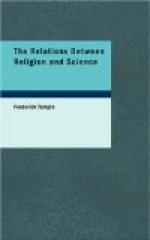And there is the more reason for this because it is undeniable that both the definition and the universality of the relation of cause and effect, as they were accepted by Hume and his followers, are not accepted by men in general. In ordinary language something more is meant by cause and effect than invariable sequence, and the common assumption is not that all Nature obeys this rule with absolutely no variation, but that the rule is sufficiently general for all practical purposes.
If then we begin by asking what is the process of Science in dealing with all questions of causation, we find that this process when reduced to its simplest elements always consists in referring every event as an effect to some cause which we know or believe to have produced some other and similar event. Newton is struck by a falling apple. His first thought is, ‘how hard the blow.’ His second is wonder, ’how far the earth’s attraction, which has caused this hard blow, extends.’ His third, ‘why not as far as the moon?’ And he proceeds to assign the motion of the moon to the same cause as that which produced the motion of the apple. Taking this as a working hypothesis, he examines what would be the motions of all the planets if this were true. And the examination ends with establishing the high probability of the Law of Gravitation.
Now this being the invariable process of Science, it follows that our conception of cause must come originally from that cause which we have within ourselves and with which we cannot but begin, the action of the human will. It is from this action that is obtained that conception which underlies the ordinary conception of cause, namely, that of force or power.
This conception of force or power is derived from the consciousness of our own power to move our limbs, and perhaps too of passions, temptations, sentiments to move or oppose our wills. This power is most distinctly felt when it is resisted. The effort which is necessary when we choose to do what we have barely strength to do, impresses on us more clearly the sense of a force residing in ourselves capable of overcoming resistance. Having the power to move our limbs, and that too against some resistance, we explain, and in no other way can we explain, other motions by the supposition of a similar power. In so doing we are following strictly the scientific instinct and the scientific process. We are putting into the same class the motions that we observe in other things and the motions that we observe in ourselves; the latter are due to acts of our own wills, the former are assigned to similar acts of other wills. Hence in infancy, and in the infancy of mankind, the whole world is peopled with persons because everything that we observe to move is personified. A secret will moves the wind, the sun, the moon, the stars, and each is independent of the others.




